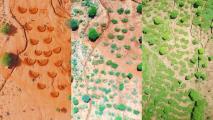In our never-ending quest to control the weather, scientists have come up with what arguably may be the most promising technique thus far: use electrocution to force rain from a cloud.
By analyzing the energy within raindrops, the team from the University of Reading in the U.K. found that they could squeeze water from the clouds by electrically supercharging them.
How it works: When clouds become saturated, the water vapor condenses into heavier vapor droplets and eventually falls to Earth. But to form these heavy droplets, the water needs a significant opposing charge to connect — opposites attract.
“This advances our understanding of how charge influences drop growth and brings a new aspect to answering the age-old question: why does it rain?”
Giles Harrison
Or so we thought. But, Futurism reports, the team found that water drops that are unevenly charged will still connect, even if they have the same kind of charge. If one droplet has a greater charge than the other, they don’t always have to be opposites.
They just need to be different. According to the study, published in the journal Proceedings on the Royal Society A, the charge will transfer from one droplet to the next, creating an “attractive force” for drops nearby.
“This advances our understanding of how charge influences drop growth and brings a new aspect to answering the age-old question: why does it rain?” Giles Harrison, a meteorologist at the University of Reading, told the Guardian.
What’s more, the charges in water droplets can also shift as they pick up ions from a nearby electric field. A greater variation in electrical charges means a higher attraction between droplets.
So by introducing electric fields to clouds, we could increase the likelihood of raindrops sticking together, encouraging rainfall. In a water-stressed region, the idea is that this could make cloud droplets heavy enough to reach the ground before they evaporate again.
Harrison and his colleagues actually attempted to shock clouds with an electric charge last year. They built four custom drones that can zap the sky. Each drone has a 2-meter wingspan, catapult launch system, and the ability to fly for 40 minutes on autopilot, reports CNN.
The team hopes that this new laboratory research could further refine their drone work.
Rain control elsewhere: This research on the electrostatic forces between water droplets was funded by the United Arab Emirates, one of the driest countries on the planet. In 2017, the UAE invested $15 million in rain-enhancement research to address water security challenges in arid regions.
Another project involves building towers to overload low-lying clouds and fog banks with an electrical charge to encourage rain.
The U.A.E. is far from alone in wanting to control the weather.
In 2008, China sprayed salt into the sky, hoping to force clouds near Beijing to rain early so they wouldn’t ruin outdoor Olympic games. This is a type of weather modification called “cloud seeding,” which disperses particles into the air so that water can condense to form raindrops.
In the U.S., researchers are experimenting with cloud-seeding to protect water-stressed regions from megadroughts. But despite our best efforts, even the most promising cloud-seeding studies have had minimal success rates and come at a hefty price.
“Understanding the role of electric charge in the generation of rain could boost precipitation levels without the use of artificial chemicals,” Harrison, the lead author on the electrostatic study, said in a statement.
Making it rain when and where we want it is a promising prospect — especially as drought-stricken regions face climate change. But it does raise some difficult questions. Some question whether pulling down rain in one region will take rain away from other places. Who gets to decide where it rains, and who should have the power to control the weather?
We’d love to hear from you! If you have a comment about this article or if you have a tip for a future Freethink story, please email us at tips@freethink.com.






